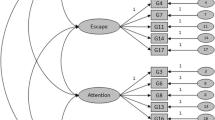Abstract
Reversal theory (Apter, 1982) provides a conceptual framework for the study of homeostatic psychological systems with multiple points of stability. This theory is applied to the explanation of normal and pathological gambling with special attention given to Apter's distinction between Telic (goal oriented) and Paratelic (playful) States. The entry of an individual to an episode of gambling is interpreted as a means of achieving a reversal or switch from one metamotivational state to another and so affecting the hedonic tone of the experience of arousal. The action during an episode of gambling is interpreted as a series of rapid switches from Telic to Paratelic States. Exit from the gambling situation is interpreted as resulting from a reversal from Paratelic to Telic metamotivational states. Scores of regular gamblers on the Telic Dominance Scale are related to their scores on the Sensation Seeking Scale, The interrelationship of arousal and reversals is used to advance an explanation both of some of the rewards of normal gambling and of the continued persistence of pathological gamblers in the face of punishing losses.
Similar content being viewed by others
References
Anderson, G. & Brown, R. I. F. Sensation secking and arousal in real and laboratory gambling.British Journal of Psychology, 85 1984, 401–410
Apter, M. J. Some data inconsistent with the optimum arousal theory of motivation.Perceptual and Motor Skills, 43 1976, 1209–1210
Apter, M. J. The experience of motivation: The theory of psychological reversals. London: Academic Press, 1982
Brown, R. I. F. Arousal and sensation seeking components in the general explanation of gambling and gambling addictions.International Journal of Addictions, 1986, in press
Eysenck, S. B. G. & Eysenck, H. J. The place of impulsiveness in a dimensional system of personality description,British Journal of Social and Clinical Psychology, 16 1977, 57–58
Eysenck, S. B. G. & Eysenck, H. J. Impulsiveness and venturesomeness: Their position in a dimensional system of personality description.Psychological Reports, 43 1978, 1247–1255
Lesieur, H. R. The compulsive gambler's spiral of options and involvement.Psychiatry, 42 1979, 79–87
Mathews, G. Personality and motivational trait correlates of the telic dominance scale.Personality and Individual Differences, 1985, in press
Murgatroyd, S., Rushton, C., Apter M. J. and Ray, C. The development of the Telic Dominance Scale.Journal of Personality Assessment, 42 1978, 519–528
Zuckerman, M.Sensation seeking: Beyond the optimal level of arousal. Hillsdale, New Jersey: Lawrence Erlbaum Associates, 1979
Author information
Authors and Affiliations
Rights and permissions
About this article
Cite this article
Anderson, G., Brown, R.I.F. Some applications of reversal theory to the explanation of gambling and gambling addictions. J Gambling Stud 3, 179–189 (1987). https://doi.org/10.1007/BF01367439
Issue Date:
DOI: https://doi.org/10.1007/BF01367439




